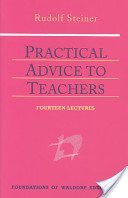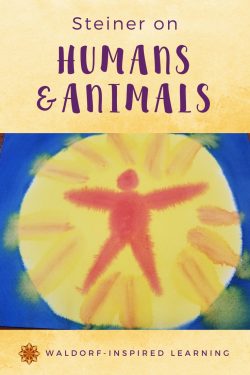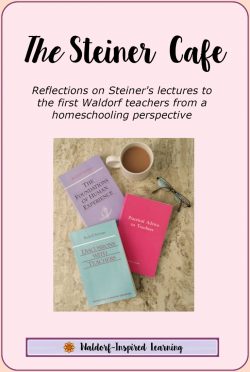Many Waldorf homeschoolers express their difficulty or even discomfort with what is known as the Man and Animal block traditionally presented in fourth grade. I have had a hard time myself with some of the concepts some years. But reading Steiner’s description of this block is freeing. It finally makes sense.
This post contains affiliate links for your convenience. You can read my full disclosure policy here.
 Steiner’s lecture to teachers on Day Seven in Practical Advice to Teachers is all about schooling the child age nine and up. Here he emphasizes a definite BREAK from the method used for children before the nine year change.
Steiner’s lecture to teachers on Day Seven in Practical Advice to Teachers is all about schooling the child age nine and up. Here he emphasizes a definite BREAK from the method used for children before the nine year change.
I collaborated with my friend Alison on this post and here are her wise words:
I think this is VERY important to us as homeschoolers, that we as teachers grow and expand and deepen our teaching approach as our children grow and mature. Don’t keep them stuck in the nursery forever. Their entire being – heart, hands and head – yearns for the type of instruction that Steiner is promoting here. They are ready to not just co-exist with the world but to step out and OBSERVE it. That is why the man and animal block is such a genius move by Steiner. Animals are a delight to observe. And children of this age not only have a natural affinity for animals, they now have the language available to them to make these observations.
Steiner opens his lecture by stating that “country schools sometimes have the better teaching methods” because with less equipment, teachers have to rely more on “the powers of invention and simple devices.” And as teachers, we need more tools and equipment after the age of nine. The biggest benefit of a country school is that during this particular block, they can bring the animals right into the classroom for the children to observe!
As a recap, Steiner notes that natural history before the age of nine is presented in narrative form (stories). However, after the age of nine, children need more specific descriptions and in-depth comparisons.
This is one of the places where Steiner makes an ultimatum: “Lessons will be ruined if we don’t start natural history lessons by describing man.”
His reason is that humans are a synthesis of three kingdoms of nature. Not that we tell the children this. But we must know it and show them that the three kingdoms of nature – represented by the head, trunk and limbs – are brought together in human beings. In other animals, only one aspect of nature is represented at a time.
Alison and I both want to happily emphasize that Steiner models an approach here that is heavy on detail and light on weird abstract comments about the human being and our place in the chain of beings. Because this is often how many of us come away from others’ explanations of this block.
Steiner suggests, “Perhaps you will start by describing man’s external appearance to the nine-year-olds.”
Steiner’s example is a drawing activity where the head is round like a ball, perched on the trunk, awakening the feeling and will element. The trunk is then a fragment of the head like the sliver of a moon carved off, sitting below the ball holding it up. The limbs are then appended onto the trunk, added on, inserted from the outside. Steiner also suggests that perhaps in addition to drawing this image, children could model the form out of wax or kneaded dough.

But the most important message of this lesson is that human beings have feet that carry us about and arms and hands that allow us to be of selfless service to the world.
Steiner says that only after these exercises of imagining the human body in this way (so that we can conclude the lesson by conveying the message that we are capable of doing good in the world) do we move on to the rest of natural history.
In studying individual animals, the first step is to familiarize the students with that animal by way of a complete description including where it lives. It’s ideal to bring a live animal to the classroom, Steiner says, or to make a drawing. One year in our family’s homeschooling, we were able to borrow a diorama of a taxidermied field mouse from our natural history museum for sketching.
The animals that Steiner uses as examples include:
- a cuttle-fish as the best representative of the head;
- a mouse, lamb, horse or other mammal which represents the trunk; and
- human beings, in which the limbs are the most significant
In our detailed descriptions of the animals, we want to give children “a certain feeling for the difference between animals” by way of comparison to human beings.
“By teaching in this way we gradually awaken in the children a strong sense and feeling for the fact that the character of the lower animals is head-like, that of the higher animals is trunk-like, and that of man limb-like.”
The end result is the the moral element: children are left with a strong impression that we humans can take up a piece of chalk and write, and we can do this because our hands and arms are not needed for other work. Steiner says, “there is no more wonderful symbol of human freedom than man’s arms and hands.”
Steiner explains that this is a very important approach to take in teaching about animals. Because so often, we hear the message that human beings are higher beings because of our heads, our thinking. Steiner wants to instill the message that we are higher beings because of our limbs and that all of the activities of nature are united in us. This helps to develop a firm moral concept in children by appealing to their intellect and strengthening their feeling and will.
Steiner concludes by saying that we want to guide children to understand how we are only fully human when we use our hands for working in the world. And we will not achieve this moral component if we only describe each animal by itself.
Alison: this is exactly why I so enjoyed this lecture. It was so far less top heavy on theory than all the other stuff I have read about this block over the years. And it is our LIMBS that are the real juicy difference rather than our HEAD. Everything else I’ve read on this block seems to emphasize our head. But emphasizing the limbs completely changes the moral seed that might start to take root in this block.
The chapter ends with a very interesting description of Goethe’s activities in nature as a child.
Sound like a description of a Nature Table, anyone?
“When (Goethe) was seven he built himself an alter to nature, taking his father’s music stand and placing on it plants from his father’s herbarium and also minerals and crowning it all with a little incense candle that he lit by focusing the beams of the morning sun with a burning glass; an offering to the great god of nature, a rebellion against everything imposed on him by education.”
Looking for more resources for animal study? Check out the titles below.
May you find new ways of working with the Human & Animal main lesson block after reading these reflections!
The Steiner Cafe is a place to explore and reflect on the lectures that Rudolf Steiner gave at the Teacher’s Seminar in 1919, the very first Waldorf teacher training.
To read reflections on previous lectures, check out The Steiner Cafe.
These lectures are published in three books. Below are affiliate links for your convenience. Click here to read my full disclosure policy.
The morning lectures are found in The Foundations of Human Experience; later morning lectures in Practical Advice to Teachers; and afternoon lectures in Discussions with Teachers.
We invite you to pick up the books and read along. Or if you prefer, you can read online at www.rsarchive.org. Or listen at www.rudolfsteineraudio.com.
Lot’s of options! Hope you’ll join in the conversations.




Wow, this is perfect timing for me, as we just began this block this week. I have been struggling with what felt like mixed messages in some of what I’ve been reading. Of course, reading Steiner himself helps clarify things! 🙂
Enlightening to read Steiner himself! So glad this is helpful to you right now.
Oh, fabulous post, thank you thank you! I am currently struggling my way through this block. I suppose I am not understanding it fully, but I am also having difficulty bringing it to life from the Waldorf perspective.
I’ve been there! This lecture helped me to simplify. First look at the human form, then pick just a few animals to observe: one to represent the head and another one or two to represent the trunk. Then come back to the human form and point out that we are unique because we have limbs that aren’t needed for other functions. So we can use them to do good in the world! Love the simplicity in this. I’d love to hear how the lessons turn out after digesting this!
Thanks, Jean. Actually, that is what we have been doing, but I have feared it was too simple! Glad to know I am more on the right track than I thought.
This block was probably my biggest flop so far. My ds felt he already knew a lot about most of the animals we covered, and he wasn’t all that interested in the classic “eagle, lion, cow” trio, so he was not all that engaged. I have to admit to feeling very confused by the head, trunk, limb categorization, particularly when different “experts” put the same animals into different categories. Even now, having read so much and taught the block, I still feel uncomfortable about it. It’s very hard to teach something you don’t understand yourself and I have to admit that Steiner’s theory just doesn’t make sense to me. So I was glad when the block finished!
A shame really that two animal lovers came away from this subject feeling flat when it should have been a block we loved. We did a brief re-cap later in the year which was much more successful because we both picked one animal to learn about that we feel passionate about. I think if I had the opportunity to teach this block again I would probably leave out the head/trunk/limb and thinking/feeling/willing part for the child because it was just too confusing. One can still come to see that animals are specialists and that humans use their limbs to do good in the world without the categories, and isn’t that the main lesson here?
I do wonder how many people truly understand this block……would love to hear I’m not the only confused soul out there 🙂
I felt that way my first time around too! A flop. You are not the only one confused out there; I’ve heard that about this block so many times. There are also contradictions out there for sure. But reading this lecture was so enlightening for me. I really believe that Steiner’s main intention here is to show that we humans are capable of doing good in the world in a conscious way. And the purpose of this block is to awaken that awareness up in our children. Finding a way to do that is our task. After reading this, I am convinced that a good approach could be to draw the five pointed star of the human (head and 4 limbs), look at one head animal and then one trunk animal. And then come back to all the things we can do with our hands. It can be quite simple, really. Quite a journey for us too, isn’t it!?!
Hi Jean,
I would not teach with the idea that human beings are higher in any way than animals, because it sends a false message. Our hands allow us to do marvellous things, but this does not make us superior to other life forms. One great freedom we have is the ability to question this age-old sense of human superiority that has wrecked such destruction on both human and nonhuman life. I believe that one should be able to take the great aspects of Steiner’s teachings, and your excellent approach to explaining it, without the need for such discrimination.
Thanks for considering,
Heinrich Yulke
I totally agree! We definitely do not want to teach that we are suprior to animals. What we are teaching is just as you say, that our hands allow us to do marvelous things. And we have the choice as to how we use that capability. Let us choose to do good in the world.
Hi Jean and Heinrich,
four years later, but I would like to adjoin my thoughts on that subject. (I’m a Waldorf teacher from Germany, hope you understand my English.) Of course I wouldn’t teach my class anything about humans beeing superior, I would not compare the worthiness of one living creature to another. We are all creatures of nature. But we do talk in class about our abilities, for example the ability to wilful choose our actions, and the responsibility that thereby arises. In addition to the realization of what distinguishes us from the animal kingdom due to our upright posture and our freely usable hands, it is precisely the ability to freely decide inwardly for or against an action.
I hope this was understandable! I really like your blog.
Best wishes, Friederike
Yes, Friederike, that’s exactly it! Through comparison, discovering that we as humans can choose our actions and embrace the responsibility that comes with that. Beautiful and thank you for sharing here. ?
Thank you for this post. I am reading and preparing for 4th grade. Laying out 2 blocks for Animal and Human. My take after reading and listening to Steiner is not that we are higher beings it is that we are to do good for the world of people and animals. Do good services. To take care of animals. To realize that it takes more will than the thinking to achive anything with our hands. That the WILL is very important. I will incorporate local animals in our region. I am excited to do these two blocks. We will use a wooden human model in the art section at most retail chain stores to move and manipulte it. I will also get plastic animals at Hobby Lobby of the animals we will use. We will model the animals with non drying clay along with water color and drawings of the lessons. Blessings to all that venture into this block!
Thank you, Emily! So lovely isn’t it to think of bringing this as a way to encourage doing good deeds in the world. To be of service. Blessings to you as you venture into this block!